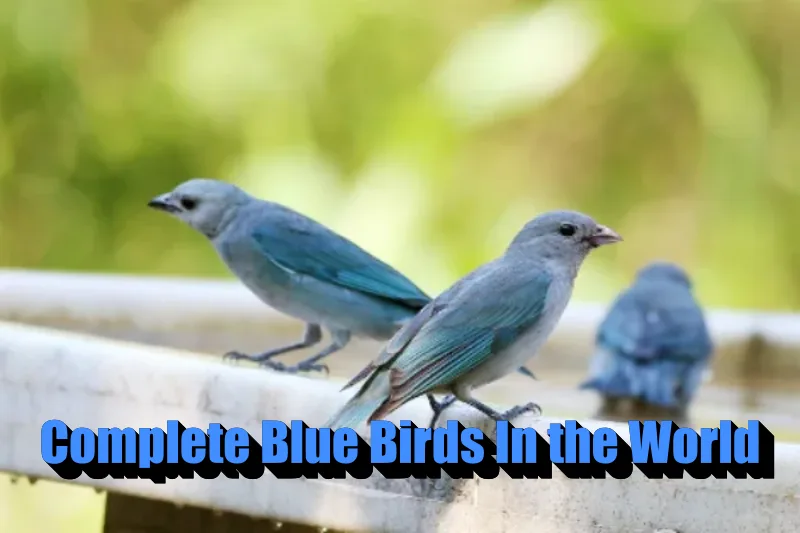I think the most attractive feature of animals is their coloration. We learned about animals in childhood by their colors, like a blue bird, a green bird, and so on.
My experience is similar. I was and still am attracted by these gorgeous animals and their colors. Last week, on my way to the department, I saw a beautiful blue bird. I discovered that this lovely bird is a blue whistling thrush.
I studied their behavior and looks, compiled a list of additional full bluebirds, and decided to share it with you all. So here’s a list of ten full-blue birds that you might like.
10 Blue Birds In the World
1. Blue whistling thrush
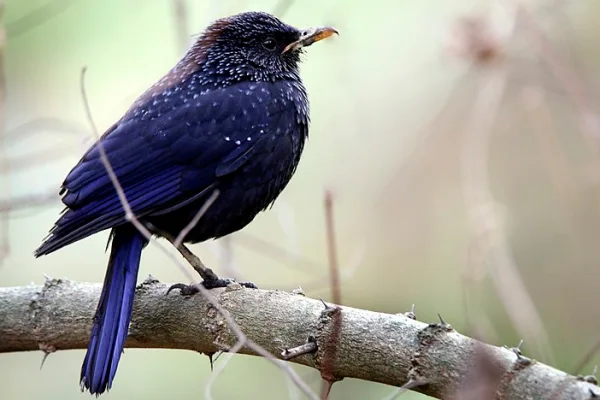
| Scientific name | Myophonus caeruleus |
| Size | 31–35 cm |
| Geographic location | Central Asia, South Asia, China, and Southeast Asia |
| Identification | Have shiny spangling on the tips of the body feathers |
The first blue bird we have on our list is Myophonus caeruleus, commonly known as the Blue Whistling Thrush.
These beautiful birds are known for their whistling sounds, which are quite similar to those of humans. These birds have an exquisite beauty that makes you fall in love with them.
They are dark purplish blue in color with shiny dotes or spangling on the tips of their body feathers, which make them really incredible.
In November, you may see them more regularly in Central Asia, South Asia, China, and Southeast Asia.
2. Cape Starling

| Scientific name | Lamprotornis nitens |
| Size | up to 25 cm |
| Geographic location | South Africa, Angola, Botswana, Gabon, Lesotho, Mozambique, Namibia, Zambia, Zimbabwe |
| Identification | Have blue head with darker ear coverts |
Red-shouldered glossy starling or Cape starling are some of the common names of Lamprotornis nitens.
This bright, glossy blue bird can attain a size of up to 25 cm. Their heads are blue with dark ear coverts. During the non-breeding season, these gregarious birds congregate in big groups.
Yellow eyes are a distinguishing trait of these lovely ladies. Their young stages have matt plumage that changes color over time.
3. Hyacinth macaw
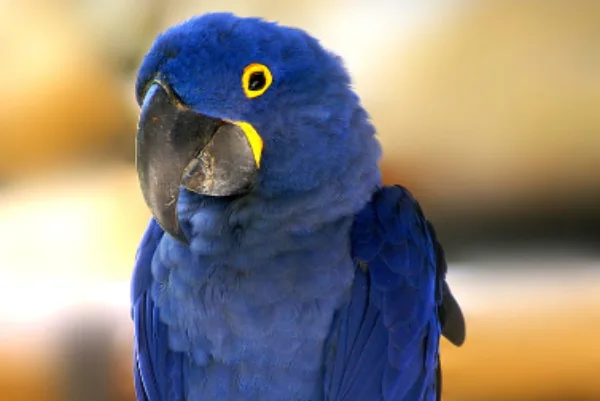
| Scientific name | Anodorhynchus hyacinthinus |
| Size | up to 1 m |
| Geographic location | Central and Eastern South America |
| Identification | Have yellow eye ring and bill base |
The next blue bird species we have on our list is the Hyacinth macaw, scientifically known as Anodorhynchus hyacinthinus. The Hyacinth macaw is the largest parrot in the world and can attain a size of up to 1 m.
They are completely blue, save for a brilliant yellow ring around their eyes and a yellow area under their beak. It mostly consumes nut species, particularly palm species.
They are reported to use tools in the wild as well as in captivity. You can find them in central and eastern South America.
4. Blue-gray tanager
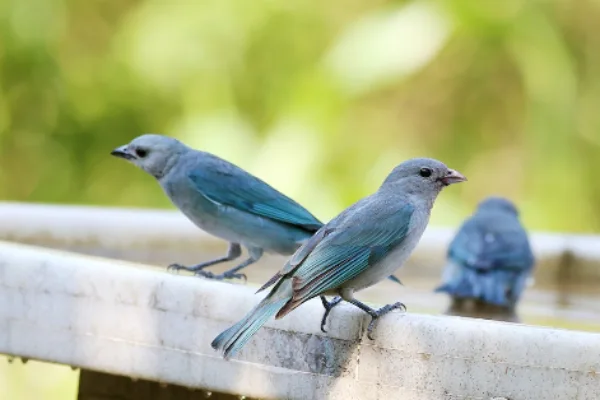
| Scientific name | Thraupis episcopus |
| Size | 16–18 cm |
| Geographic location | Mexico, Central America, and the Northern part of South America |
| Identification | light blue head and underparts |
Blue-gray tanagers are a blue bird species commonly found in Mexico, Central America, and the northern part of South America. As their name suggests, they exhibit blue-gray plumage.
They have characteristically bright blue heads and upperparts with pale grayish blue underparts. They are known to visit fruiting trees and flowers to forage for food.
5. Mountain bluebird
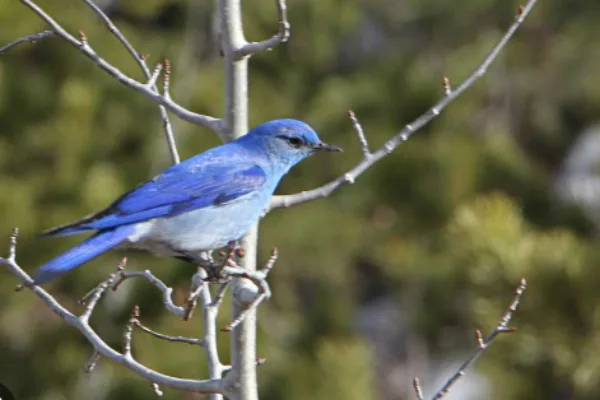
| Scientific name | Sialia currucoides |
| Size | 6 to 7 inches |
| Geographic location | Western North America |
| Identification | Have a white ring around their eyes. |
Meet this state bird of Idaho and Nevada. In Western North America, these mountain blue birds are very common.
These beautiful birds exhibit bright blue plumage. Males are brighter in color than females.
These medium-sized birds, with an average size of 6 to 7 inches, are monogamous. The diet of these beauties is composed of insects, berries, and fruit seeds.
6. Lear’s macaw
| Scientific name | Anodorhynchus leari |
| Size | 70–75 cm |
| Geographic location | Brazil |
| Identification | It’s a blue macaw with yellow facial skin |
Here is the Hyacinth Macaw twin, Lear’s Macaw. They are so similar in appearance that people often get confused between them.
They are metallic blue with yellow eye rings. Lear’s macaws primarily feed on the nuts of licuri palms. According to the IUCN Red List, they are considered endangered.
7. Little blue heron
| Scientific name | Egretta caerulea |
| Size | up to 29 inches |
| Geographic location | Western Hemisphere in North America, Central America, West Indies, and South America |
| Identification | mostly grayish-blue with a contrasting deep purplish head and neck. |
The little blue heron is a medium-sized bird that can attain a size of up to 29 inches and exhibits beautiful blue hues.
In their juvenile stage, they are white in color, and gradually they turn bluish gray with a two-toned bill as they age.
They were found in the western hemisphere of North America, Central America, the West Indies and South America, inhabiting various wetlands habitats such as freshwater and brackish marshes, ponds, rivers, estuaries, and coastal areas.
8. Indigo Bunting
| Scientific name | Passerina cyanea |
| Size | 4.5-5.9 inches |
| Geographic location | North America and South America |
| Identification | Have shiny silvery-gray bill |
Passerina cyanea, commonly known as Indigo hunting, is a small, incredibly colored songbird native to North and South America.
Males of this species occur in vibrant cerulean blue hues, especially when they are trying to attract their mate.
These beautiful buddies migrate at night and use stars for navigation. They usually construct cup-shaped nests in dense shrubs or small trees.
9. Nilgiri flycatcher
| Scientific name | Eumyias albicaudatus |
| Size | up to 13 cm |
| Geographic location | Nilgiris, Palni Hills, Anaimalai Hills, the Brahmagiri, Bababudan Hills, and Biligiriranga Hills |
| Identification | they are steely indigo blue in color |
Nilgiri Hills are not only famous for their coffee plantations but also for these really cool and beautiful birdies.
These old-world flycatchers are small birds with an average size of up to 13 cm. Talking about their appearance, males are dark steely indigo blue in color, whereas females are dull in color.
These birds are known for their agility and active behavior while foraging.
10. Great Blue Turaco
| Scientific name | Corythaeola cristata |
| Size | 70 to 76 cm |
| Geographic location | Africa |
| Identification | Bright blue bird with yellow beak with red tip |
The Great Blue Turaco is our final member of this list of ten full blue birds. These are the amazing birds found in Sub-Saharan Africa.
These birds are distinguished by their huge size, remarkable appearance, and vibrant colors.
They have a vivid blue body and a prominent yellow beak with a red tip. These sociable diurnal birds dislike migration.
Conclusion
This concludes my post on ten full blue birds. This post will go over these lovely creatures.
From the vibrant plumage of the Great Blue Turaco to the striking coloration of the Blue Whistling Thrush, we’ve compiled a list of all the blue-feathered species’ best features.
There will be another post soon; in the meantime, enjoy these natural wonders.
Also Read:

Being a zoology student I’m always been fascinated toward animals especially insects. I love to do research and learn about different animals. As a writer I want to share my thoughts about nature through my articles. Apart from this you can find me exploring the new places and voice notes.
